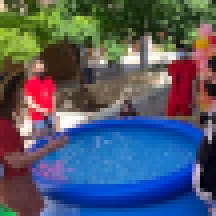
Everywhere you look, it seems, people are talking about “learning loss,” or how much students haven’t learned during the tumult of the past two years. But for all the conversations in the news and on social media, one place we’re not seeing it as much is in schools themselves. At the Institute for Teaching and Leading, a professional learning organization that I co-founded, many of our partner districts are focused less on deficits and more on active learning, which we call the asset-based mindset.
Instead of endless conversations about what students missed out on, school leaders are increasingly talking about “unfinished learning,” a term that acknowledges that students across the country had wildly diverse learning experiences over the past year. And with the shift in terminology comes a shift in practice. An asset-based approach emphasizes acceleration and enrichment, with a focus on designing rich, high-quality instructional experiences that provide accessible entry points for all students.
As a bonus, these accelerated learning approaches give a lower priority to repetition or “skill-and-drill” uses of instructional technology. In other words, it’s not about memorizing everything you should have learned, it’s about moving you forward so you pick things up along the way.
The design of a summer adventure program at Santa Fe Public Schools exemplifies some of the best of these emerging acceleration strategies. While summer school often conjures up images of reluctant students sitting in rows, watching the clock or gazing out the window, the scene inside Santa Fe’s Math Adventure Camp could not be more different. There, students are embarking on a quintessential hero’s journey—all about the high seas—that centers an asset-based approach to the teaching of math.
And the action is everywhere: an indoor plastic pool awaits student design teams testing their ship prototypes, while in the courtyard, groups of students engage in a game that both explores and challenges their perception of themselves as mathematicians. In a nearby classroom, other teams wrestle with the daily challenges of turning a profit on the high seas. Everywhere, students and teachers alike sport red t-shirts with the summer camp motto: “Will You Sink—or Swim?”
The summertime “call to adventure” in Santa Fe Public Schools began when Peter McWain, director of curriculum and instruction, roamed the halls this spring in a pirate costume, challenging eighth graders to embark on a new summer math quest. In the course of the summer school program, students travel back in time to the 1600’s, where they face down their math fears in an immersive math experience called “Fate and Fortune.” Designed by the MidSchoolMath curriculum company as one of several standards-aligned math game platforms, students in the program manage their own Renaissance-era shipping companies, traveling around the world to purchase and sell spices, negotiating trade and driving hard bargains all while navigating pirate-infested waters.
The narrative-driven math game engages students and teams in collaboration, creativity and deep critical thinking as they work to construct expressions, build equations and apply fundamental algebraic logic, all within the adaptive context of the game.
Learning, Accelerated
While we’re still digesting many of the lessons learned from the past 18 months, research from the math classroom points to some promising practices around learning acceleration. One study by TNTP and Zearn Learning shows that students who experienced instructional strategies based on acceleration struggled less and retained more than students who experienced instruction based on mostly remedial strategies.
And while students from low-income backgrounds and students of color were more likely to experience remediation as their primary instructional modality—even when these students had already demonstrated mastery of grade-level standards—a switch to learning acceleration was particularly effective for these same groups. For Santa Fe, a district serving a student population that is 84 percent students of color, and where three-quarters of students are eligible for the federal lunch program, these were important considerations.
Here are five key take-aways they’ve learned so far on their quest:
Designing with education equity in mind.
Often summer school programs are designed for credit recovery or filling in learning gaps. But for Santa Fe, inclusion was key. The program was opened to all incoming freshmen across the district, with a plan to include additional high school-aged students serving as mentors in the future. The district worked to ensure that all students and families would have the resources they need to meaningfully engage in the program, such as providing that breakfast and lunch would be served each day.
Similarly, far from being an additional task or added duty, teachers underwent a rigorous application process; selected teachers benefitted from two days of additional professional learning and worked collaboratively to design the student learning experience, at times with input from students themselves.
Focus on gatekeeper standards.
While acceleration strategy encourages exposure to grade-level standards, it also acknowledges that not all standards are created equal. Some standards are so foundational that failure to master them sets a student up for significant struggle later on—hence the term “gatekeeper standards.” The “Fate and Fortune” game used by Santa Fe embeds ten key standards that correlate most closely with Algebra I success.
In the state of New Mexico, where 81 percent of students tested below proficiency on the 2019 Algebra I statewide Transition Assessment, programs like this one can be a game-changer in preparing students for Algebra I and shifting historically low outcomes.

Multi-dimensional project-based learning.
Project-based instruction provides the opportunity to design rich, engaging and relevant learning tasks that all learners can access, using strategies from what has been called “complex instruction” or “low floor/high ceiling” learning.
All too often, districts using educational technology revert to its lowest form of uses—such as credit recovery or skill-and-drill—to remediate or recover so-called lost learning; here, Santa Fe’s summer program offers hands-on design challenges as students brainstorm their ship design, build prototypes, test and then iterate their creations in a series of sprints. Students who are struggling with the math concepts work them through using visual modeling (as well as traditional pen-and-paper). Often, the story-based approach—and somewhat competitive nature of the game—means that students are keen to quickly activate their prior knowledge as they wrestle with the math problems embedded in the game.
Move to a competency-based focus.
Aligning complex instruction to standards ensures accountability and readiness. In a competency-based experience, students are aware of the standards they are striving to meet and can both describe their progress toward them and help chart their own “next steps” for growth.
In the summer program, students move through the math game with a clear understanding of which challenges they have overcome and which ones lie ahead; they also have autonomy to choose how, where and when they will encounter each kind of problem. Teachers support them with mini-lessons, time to collaborate in teams and by coaching them through the productive struggle.
In younger grades, competency-based acceleration strategies focus largely on reading/writing, phonic development, and the ability to read for learning and comprehension. But in later grades, the focus shifts to math skills and standards such as fractions, decimals and percent work, moving to expressions, equations and functions. Focusing on mastery allows educators to stay oriented around what students can do, as opposed to what is missing, and encourages a growth mindset.
Embedding a social-emotional learning lens into instruction.
Finally, in the wake of the pandemic, districts are working to include non-academic standards, such as social-emotional learning or character education, into their learning models. Because students and families had such wildly diverse learning experiences over the past 18 months, there is an increased focus on social-emotional learning support and ensuring that all students feel like they belong and are welcomed and valued in their school experience.
For the Santa Fe Math Adventure Camp, this means helping students reflect upon themselves as learners and to develop a strong sense of their math identity; teachers play learning games and host explorations into diverse areas of STEM that help students see their own cultural identities reflected in real-world jobs and careers.
While the high energy and excitement is palpable, and quite a change from the traditional summer school model, the Math Adventure program stands out for other reasons as well. In many ways, it anticipates what many in education hope will become the norm of post-pandemic teaching and learning.

